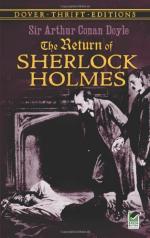The day was just breaking when I woke to find the long, thin form of Holmes by my bedside. He was fully dressed, and had apparently already been out.
“I have done the lawn and the bicycle shed,” said, he. “I have also had a rumble through the Ragged Shaw. Now, Watson, there is cocoa ready in the next room. I must beg you to hurry, for we have a great day before us.”
His eyes shone, and his cheek was flushed with the exhilaration of the master workman who sees his work lie ready before him. A very different Holmes, this active, alert man, from the introspective and pallid dreamer of Baker Street. I felt, as I looked upon that supple, figure, alive with nervous energy, that it was indeed a strenuous day that awaited us.
And yet it opened in the blackest disappointment. With high hopes we struck across the peaty, russet moor, intersected with a thousand sheep paths, until we came to the broad, light-green belt which marked the morass between us and Holdernesse. Certainly, if the lad had gone homeward, he must have passed this, and he could not pass it without leaving his traces. But no sign of him or the German could be seen. With a darkening face my friend strode along the margin, eagerly observant of every muddy stain upon the mossy surface. Sheep-marks there were in profusion, and at one place, some miles down, cows had left their tracks. Nothing more.
“Check number one,” said Holmes, looking gloomily over the rolling expanse of the moor. “There is another morass down yonder, and a narrow neck between. Halloa! halloa! halloa! what have we here?”
We had come on a small black ribbon of pathway. In the middle of it, clearly marked on the sodden soil, was the track of a bicycle.
“Hurrah!” I cried. “We have it.”
But Holmes was shaking his head, and his face was puzzled and expectant rather than joyous.
“A bicycle, certainly, but not the bicycle,” said he. “I am familiar with forty-two different impressions left by tires. This, as you perceive, is a Dunlop, with a patch upon the outer cover. Heidegger’s tires were Palmer’s, leaving longitudinal stripes. Aveling, the mathematical master, was sure upon the point. Therefore, it is not Heidegger’s track.”
“The boy’s, then?”
“Possibly, if we could prove a bicycle to have been in his possession. But this we have utterly failed to do. This track, as you perceive, was made by a rider who was going from the direction of the school.”
“Or towards it?”
“No, no, my dear Watson. The more deeply sunk impression is, of course, the hind wheel, upon which the weight rests. You perceive several places where it has passed across and obliterated the more shallow mark of the front one. It was undoubtedly heading away from the school. It may or may not be connected with our inquiry, but we will follow it backwards before we go any farther.”




